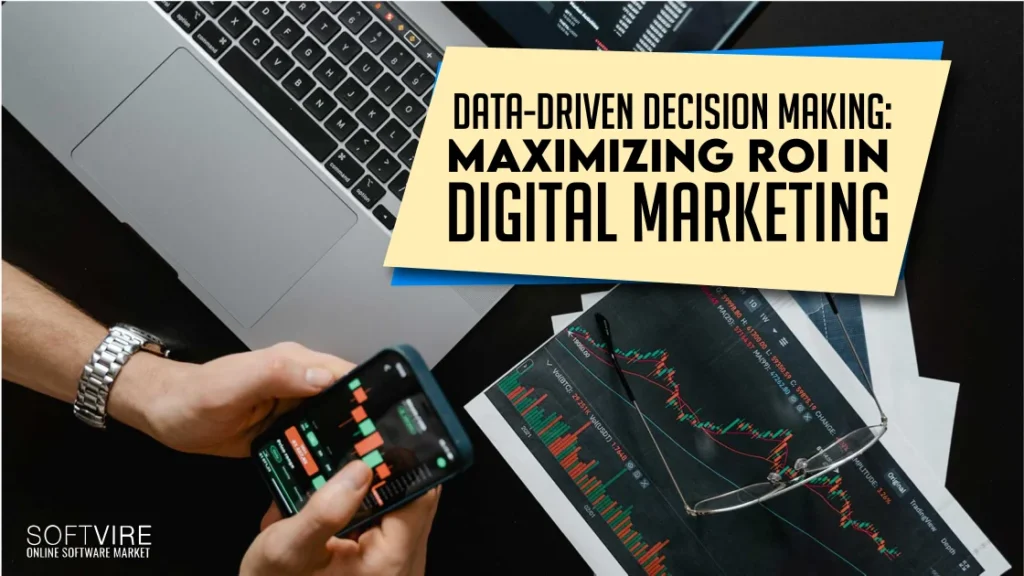I. Introduction
A. Definition of data-driven decision-making: Data-driven decision-making involves making informed and strategic business decisions based on analyzing and interpreting relevant data and insights.
B. Importance of maximizing ROI in digital marketing: In the digital marketing landscape, return on investment (ROI) is a critical metric determining marketing efforts’ effectiveness and profitability. Maximizing ROI ensures that resources are allocated efficiently, and campaigns yield desirable outcomes.
C. Purpose of the outline: The outline provides a comprehensive guide on leveraging data-driven decision-making to optimize digital marketing initiatives and achieve higher ROI.
II. Understanding Data-Driven Decision-Making
A. Definition and critical principles: Data-driven decision-making involves utilizing data to inform and support decision-making processes. Fundamental principles include the reliance on empirical evidence, objective analysis, and data integration into decision-making frameworks.
B. Benefits and advantages: Data-driven decision-making offers several advantages, such as improved accuracy, increased insights, enhanced predictive capabilities, reduced bias, and better strategic alignment.
C. data analytics and insights: Data analytics plays a crucial role in extracting meaningful insights from vast amounts of data. It employs statistical methods, data visualization techniques, and machine learning algorithms to gain actionable information.
III. Collecting and Analyzing Digital Marketing Data
A. Identifying relevant data sources: Marketers must collect data from various sources, including website analytics, customer relationship management (CRM) systems, social media platforms, email marketing platforms, and third-party data providers.
B. Collecting and organizing data: Effective data collection involves defining data collection mechanisms, setting up tracking tools, and ensuring data accuracy and consistency. Organizing data involves proper structuring and storage for easy retrieval and analysis.
C. Utilizing data analytics tools and techniques: Marketers can employ various data analytics tools and techniques, such as descriptive analytics, diagnostic analytics, predictive analytics, and prescriptive analytics, to derive insights and make data-driven decisions.
D. Extracting meaningful insights from data: Data analysis involves uncovering patterns, trends, correlations, and anomalies within the data. Marketers can extract valuable insights that inform decision-making by applying statistical analysis, data mining, and machine learning techniques.
IV. Setting Key Performance Indicators (KPIs)
A. Defining KPIs for digital marketing campaigns: Key Performance Indicators (KPIs) are measurable metrics that reflect the performance and success of marketing campaigns. Examples include conversion and click-through rates, customer acquisition costs, and lifetime value.
B. Aligning KPIs with business objectives: KPIs should be aligned with the overall business objectives and goals. This ensures that marketing efforts align with the organization’s strategic direction and focus on driving ROI.
C. Measuring and tracking KPIs effectively: Marketers must establish a robust measurement framework to track and monitor KPIs accurately. This involves setting up tracking mechanisms, utilizing analytics tools, and regularly analyzing performance data.
D. Importance of benchmarking and performance evaluation: Benchmarking KPIs against industry standards and competitors helps marketers gain insights into their relative performance. Regular performance evaluation enables them to identify areas for improvement and take data-driven actions to maximize ROI.
V. Leveraging Data for Targeted Marketing Strategies
A. Understanding customer segmentation and targeting: Customer segmentation involves dividing the target audience into distinct groups based on shared characteristics. Marketers can tailor their marketing strategies to each segment’s needs and preferences.
B. Utilizing customer data for personalized marketing: By analyzing customer data, marketers can gain insights into individual preferences, behaviors, and purchase history. This enables them to deliver personalized and relevant marketing messages, offers, and recommendations.
C. Tailoring marketing messages and campaigns: Data-driven insights allow marketers to create compelling and targeted marketing messages that resonate with their audience. They can optimize content, design, and delivery channels to maximize engagement and conversions.
D. Implementing A/B testing and optimization techniques: A/B testing compares two or more versions of a marketing element to determine which performs better. Marketers can leverage data to identify winning variations and optimize campaigns for improved ROI.
VI. Optimizing Digital Marketing Channels
A. Evaluating and optimizing website performance: Marketers can use website analytics to assess website performance, user behavior, and conversion funnels. Optimization techniques, such as conversion rate optimization (CRO) and user experience (UX) improvements, can be implemented based on data insights.
B. Enhancing search engine optimization (SEO) strategies: SEO relies on data-driven analysis to identify relevant keywords, Improve search engine ranks by optimizing website content. Marketers can leverage SEO analytics tools to track rankings, analyze traffic sources, and refine optimization strategies.
C. Leveraging social media analytics and advertising: Social media platforms provide extensive analytics tools that allow marketers to analyze audience demographics, engagement metrics, and campaign performance. Data-driven insights can inform social media advertising strategies and optimization efforts.
D. Utilizing email marketing analytics and automation: Email marketing platforms offer data analytics features to measure open, click-through, and conversion rates. Automation tools help marketers deliver targeted and personalized email campaigns based on customer behavior and segmentation.
VII. Implementing Data-Driven Campaigns
A. Developing data-driven marketing strategies: Data insights guide the development of marketing strategies by identifying target segments, defining value propositions, and selecting the most effective channels and tactics.
B. Executing targeted advertising campaigns: Data-driven decision-making informs the creation and execution of targeted advertising campaigns across digital channels. This includes precise audience targeting, ad creative optimization, and real-time bidding based on data signals.
C. Monitoring and adjusting campaigns based on data insights: Marketers continuously monitor campaign performance using data analytics tools and adjust strategies in response to emerging insights. This iterative approach allows for ongoing optimization and ensures maximum ROI.
D. Ensuring compliance with data privacy regulations: Marketers must adhere to data privacy regulations, such as GDPR or CCPA, while collecting, storing, and processing customer data. Compliance measures should be implemented to protect consumer privacy and maintain trust.
VIII. Measuring ROI and Evaluating Success
A. Calculating ROI for digital marketing campaigns: ROI measurement involves assessing the financial return generated from marketing investments. It requires comparing the costs incurred with the revenue or value generated to determine campaign profitability.
B. Assessing the effectiveness of data-driven decisions: Marketers should evaluate how data-driven decisions have influenced campaign performance and ROI. This assessment helps identify the impact of data-driven strategies and informs future decision-making processes.
C. Conducting post-campaign analysis and reporting: Marketers should conduct a comprehensive analysis after each campaign to evaluate results and identify strengths and weaknesses. Reporting findings and insights to stakeholders helps demonstrate the value of data-driven decision-making and informs future marketing strategies.
D. Identifying opportunities for further improvement: By analyzing post-campaign data and insights, marketers can identify areas for improvement and fine-tune future campaigns. This continuous improvement process helps maximize ROI and optimize overall marketing effectiveness.
IX. Overcoming Challenges and Limitations
A. Addressing data quality and accuracy issues: Data integrity and accuracy is crucial for reliable decision-making. Marketers should implement data validation processes and quality control measures and ensure data hygiene to overcome data-related challenges.
B. Dealing with privacy concerns and data security: Using customer data requires careful consideration of privacy regulations and security measures. Marketers should establish robust data security protocols, obtain necessary consent, and respect customer privacy preferences.
C. Overcoming organizational resistance to data-driven decision-making: Some organizations may face internal resistance or cultural barriers to adopting data-driven decision-making. Marketers should focus on educating stakeholders, highlighting success stories, and demonstrating the value of data-driven approaches.
D. Continuous learning and adaptation in a dynamic digital landscape: Digital marketing evolves rapidly. Marketers should prioritize continuous learning, staying updated with industry trends, and adapting strategies to leverage emerging technologies and data-driven innovations.
Conclusion:
In conclusion, data-driven decision-making is essential for maximizing ROI in digital marketing. By leveraging data analytics and insights, marketers can make informed and strategic decisions that lead to improved campaign performance and profitability.
Through the collection and analysis of digital marketing data, setting relevant KPIs, and utilizing data for targeted marketing strategies, organizations can optimize their marketing efforts. Optimizing digital marketing channels, implementing data-driven campaigns, and measuring ROI enables marketers to improve and adapt their strategies continuously.
While data quality, privacy concerns, and organizational resistance may arise, embracing data-driven approaches and staying adaptable in a dynamic digital landscape is key. By prioritizing data-driven decision-making, marketers can enhance their overall marketing effectiveness and achieve higher ROI in their digital marketing initiatives.
Are you looking for online learning tools and discounted Microsoft products? Check out our hot offers at Microsoft Softvire New Zealand. “Upgrade to the latest version of Windows 11 and unlock new features and enhanced security.”



